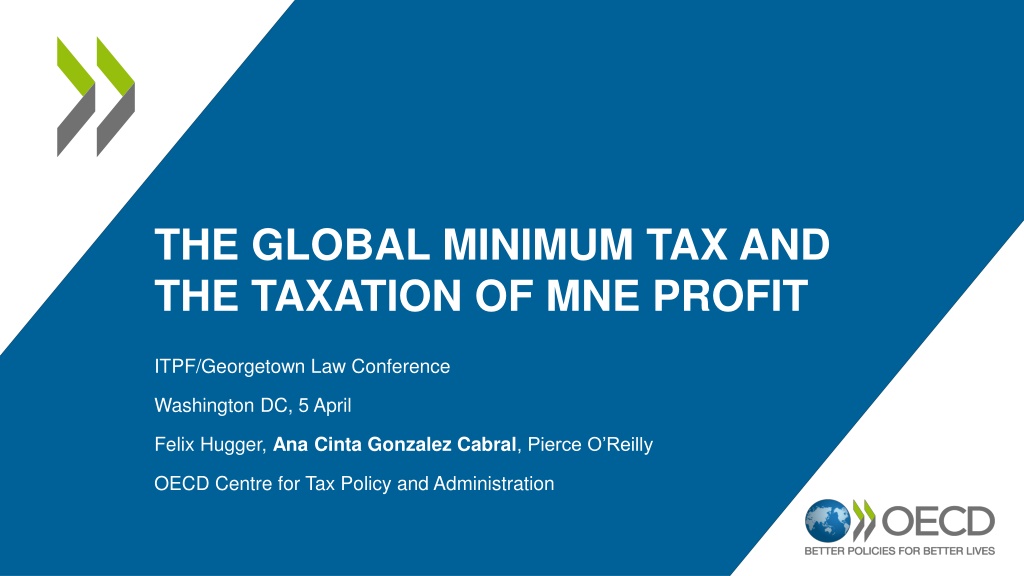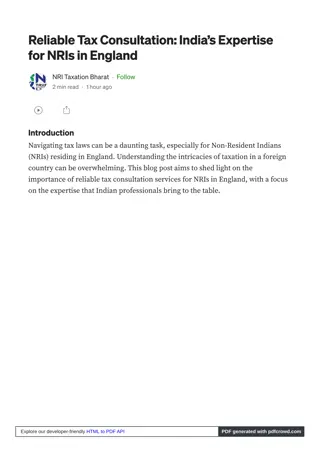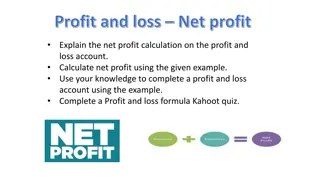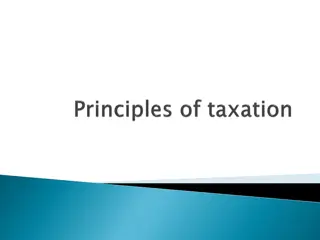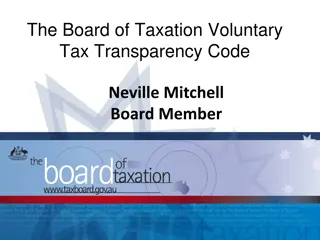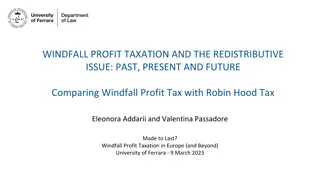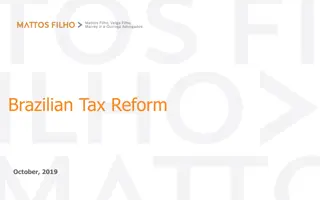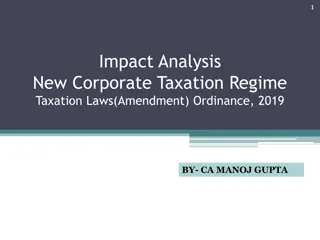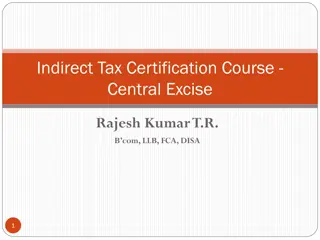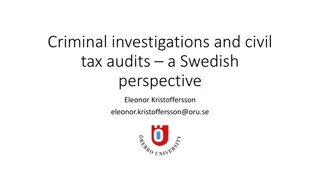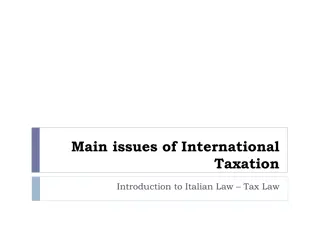The Global Minimum Tax and MNE Profit Taxation
The OECD has conducted an extensive economic impact assessment of the Global Minimum Tax (GMT) for multinational enterprises (MNEs), focusing on tax rate differentials, profit shifting, low-taxed profits, and revenue gains. The research includes building a matrix of profit locations, assessing ETR heterogeneity, applying GMT rules, and evaluating impacts on tax differentials, profits, and revenues.
Download Presentation

Please find below an Image/Link to download the presentation.
The content on the website is provided AS IS for your information and personal use only. It may not be sold, licensed, or shared on other websites without obtaining consent from the author.If you encounter any issues during the download, it is possible that the publisher has removed the file from their server.
You are allowed to download the files provided on this website for personal or commercial use, subject to the condition that they are used lawfully. All files are the property of their respective owners.
The content on the website is provided AS IS for your information and personal use only. It may not be sold, licensed, or shared on other websites without obtaining consent from the author.
E N D
Presentation Transcript
THE GLOBAL MINIMUM TAX AND THE TAXATION OF MNE PROFIT ITPF/Georgetown Law Conference Washington DC, 5 April Felix Hugger, Ana Cinta Gonzalez Cabral, Pierce O Reilly OECD Centre for Tax Policy and Administration
Context The OECD has carried out extensive economic impact assessment (EIA) of the two-pillar solution The design of the Global Minimum Tax (GMT) has changed significantly since the release of the first EIA in 2020 need for an update Two newly released working papers released contain new evidence launched 2023 and 2024 The work has a global scope (222 jurisdictions are part of the analysis) Focuses on effects on four key dimensions: 1) tax rate differentials; 2) profit shifting; 3) low-taxed profits; 4) revenue gains 2
What we are doing 1. Build a unique matrix of the location of profit and economic activities of in-scope MNEs on a jurisdiction-pair basis Data for 2017-2020, largely CbCR based, with imputations for missing variables 2. Account for the heterogeneity of ETRs within jurisdictions new evidence on low- taxed profits 3. Apply the GMT Including rule order, Substance-Based Income Exclusion (SBIE), funds exclusion, deferred tax accounting, interactions with US GILTI regime, UTPR allocation key 4. Provide for MNEs responding by reducing shifted profit 5. Provide for jurisdictions responding by topping-up domestic low-taxed profit 6. Assess impacts on tax rate differentials, low-taxed profit, shifted profit, and tax revenue 3
What we are not doing Data Based on macro aggregates, not firm level data Rules No accounting for the Subject to Tax Rule Limited accounting for a variety of adjustments made to financial accounting profit & taxes that are part of the GloBE Rules Responses No live tracking of implementation No accounting for jurisdiction responses in terms of expanded subsidies, expanded use of accelerated depreciation or other tax incentives No accounting for potential investment impacts at global or jurisdictional level No links between profit-shifting and real activity 4
Assumptions and methodology (1) 1. New methodology to look at variation of MNEs ETRs across jurisdictions Average ETRs may mask heterogeneity across firms within jurisdictions that can be due to firm circumstances or tax policies (e.g., tax incentives) We estimate an ETR distribution across MNE profit within each jurisdiction based on CbCR ratio data gathered from tax administrations Distributions of MNEs ETRs are used to map MNE profit distributions Low-taxed profits, taxed below 15%, are common across all jurisdictions ~60% of low-taxed profits are outside of investment hubs 5
Assumptions and methodology (2) 2. GloBE ETR and tax base: GloBE income approximated by aggregated data on global allocation of MNE profit Key adjustments: GloBE income corrected for potential double counting issues in aggregated CbCR data (with some caveats) GloBE ETR adjusted for losses, as in GloBE rules; assumption that other adjustments, e.g. due to accelerated depreciation, largely wash out Fund exclusion accounted for (other exclusions have little impact on global results) GloBE Income adjusted for SBIE Interaction of GloBE and GILTI modelled Most of these adjustments reduce headline revenue estimates, but important to gain an accurate picture 6
Assumptions and methodology (3) 3. Six profit-shifting scenarios regarding the elasticity of tax base relative to tax rate differentials 4. Four implementation scenarios modelled Global implementation All jurisdictions are assumed to implement QDMTT, IIR, UTPR Partial implementation Most members of the Inclusive Framework on BEPS (IF) are assumed to implement QDMTT, IIR, UTPR with probabilities of 70%, 85%, or 100% Except IF members with 1) no CIT infrastructure and 2) no public signal of GloBE implementation Non-IF member jurisdictions are assumed to not implement 7
Reduction in profit shifting Percentage change in location of profit due to reduced profit-shifting The GMT is estimated to reduce ETR differentials between investment hubs and non-hubs by around 50%, from 14 percentage points to 7 percentage points on average Lower tax rate differentials reduce MNEs incentives to shift profit to low tax jurisdictions Total shifted profit estimated to fall by around half Some of these effects may take time to materialise Note: Average changes in total profit by income group following the implementation of the GMT. Bounds are constructed using six scenarios with different assumptions regarding profit shifting reductions. Data includes non-Inclusive Framework member jurisdictions. Profit from funds as UPE are assumed to be unaffected by the declining in profit shifting incentives as they are excluded from the GMT. Total profit is profit before accounting for-profit shifting. 8
Reduction in global low-taxed profits % of global profits subject to ETR less than 15% Overall, reduction in the share of low-taxed MNE profit by 80%,from 36% to 7% of all profit globally after the SBIE transition period The effect is largest in investment hubs, where the share of low-taxed profit falls from 79% to 7% after the SBIE transition period Note: The chart refers to the extent to which total profit is low taxed by income groups. Global refers to all jurisdictions. Low taxed profit is defined as those with an ETR (loss-adjusted) lower than 15%. The Pre-P2 scenario reflects the current distribution of profit absent any GMT effects. The remaining scenarios reflect the distribution of profit once the GMT has applied to low-taxed profit accounting for the year-one and year-ten SBIE, respectively. 9
Increase in tax revenue Global revenue gains by implementation scenario, USD bn Total global revenue gains of between USD 155 bn and USD 192 bn per year Approx. 2/3 of revenue gains are direct gains via top-up taxation Approx. 1/3 of revenue gains are indirect gains through reduced profit shifting The higher the share of implementing jurisdictions, the higher the share of QDMMT revenue vs. IIR and UTPR revenue Note: The estimates are presented as an average of the 2017-2020 results. Estimates are presented for IF member jurisdictions only. Estimates include both direct and indirect revenue gains. The estimates account for the variation in the sensitivity of profit shifting. Estimates are presented for the SBIE year-one scenario (10% on payroll and 8% on tangible assets). Estimates are presented net of any lost revenue from CFC regimes modelled. Assumptions on implementation scenarios are discussed above. 10
Conclusion The GMT reduces tax rate differentials across jurisdictions Reduction in differentials between investment hubs and non-hub jurisdictions by around 50% This reduces profit-shifting incentives, and can improve global capital allocation The GMT is likely to reduce incentives to shift profit Estimated fall in global shifted profits by around 50% The GMT is likely to reduce low-taxed profit globally Global amount of MNE profit taxed below 15% is estimated to fall by about 80% Remaining low-taxed profit due to SBIE The GMT is likely to increase tax revenue Increased CIT revenues by 6.5%-8.1% of global CIT revenues (USD 155-192 billion in the 2017- 2020 period ) Two-thirds directly, one-third indirectly through reduced profit-shifting 11
References Hugger, F., A. Gonz lez Cabral and P. O Reilly (2023), "Effective tax rates of MNEs: New evidence on global low-taxed profit", OECD Taxation Working Papers, No. 67, OECD Publishing, Paris, https://doi.org/10.1787/4a494083-en. Hugger, F., et al. (2024), "The Global Minimum Tax and the taxation of MNE profit", OECD Taxation Working Papers, No. 68, OECD Publishing, Paris, https://doi.org/10.1787/9a815d6b-en. 12
ANNEX 13
Taxation of profit globally Distribution of profits across ETR bins globally and by ETR group Data highlight variety of ETRs across all ETR groups Concentration of profit in the 25-35% ETR range globally Concentration in the 0-5% ETR range (including substantial zero-taxed profit) 14 Note: Distribution of profit of large MNEs across ETR bins, averaged over the period 2017-2020. Bins have a width of five percentage points. The average sum of global profits of large MNEs is USD 5,929 billion per year.
Extent of Low-Taxed Profit compared to average ETRs Share of low-taxed profit vs. average ETRs Data show highest shares of low- taxed profits (ETR < 15%) in low- tax jurisdictions But also substantial low-taxed profits in many jurisdictions with high average ETRs (blue box) This low-taxed profit in high tax jurisdictions is ignored when only considering average ETRs Note: Very low-taxed profit compared to the average ETR in a jurisdiction. Each dot is a jurisdiction observation. The vertical line indicates 15%. Values shown are averages across the years 2017-2020 for both shares of low-taxed profit and ETRs. Low- taxed profit is defined as all profit taxed at ETRs below 15%. 15
Reduction in global low-taxed profits Distribution of total profits across ETR bins (simplified) Reduction in profit shifting and top-up taxation reduce global low-taxed profits The SBIE and other exclusions allows for some profit to remain low-taxed Overall, reduction in the share of low- taxed MNE profit by 70%,from 36% to 11% Note: Distribution of profit by effective tax rates bins in three states of the world. The Pre-GMT scenario reflects the current distribution of loss adjusted profit absent any GMT effects. The Post-GMT, PS scenario captures the distribution of profit once profit shifting incentives are reduced due to the implementation of the GMT. The Post-GMT, PS and top-up (8-10) and (5-5) scenarios reflect the distribution of profit once the GMT has applied to low-taxed profit accounting for the year-one and year-ten SBIE, respectively. Profits are computed as averages across ETR bins to ensure a smooth representation.
